This document discusses social stratification, defining it as the hierarchical arrangement of individuals based on wealth, power, and prestige, and examines various systems of stratification such as class, slavery, caste, and clan. It further explores theoretical perspectives on class inequality, including functionalism, conflict theory, feminism, and symbolic interactionism, while also detailing the measures and implications of poverty in Canada, particularly among disadvantaged groups. Additionally, the document covers the rights of union members, emphasizing the legal responsibility of unions to represent all employees fairly and without discrimination.
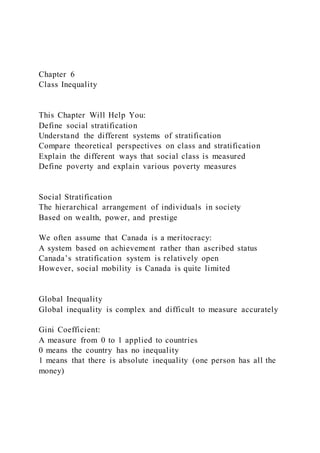









![from its membership. As the membership of the Brotherhood
constitutes a majority of all firemen employed on respon- dent
Railroad and as under Section 2, Fourth, the members, because
they are the majority, have chosen the Brotherhood to represent
the craft, petitioner and other Negro firemen on the road have
been required to accept the Brotherhood as their representative
for the purposes of the Act. On March 28, 1940, the
Brotherhood, purporting to act as representative of the entire
craft of firemen, without informing the Negro firemen or giving
them opportunity to be heard, served a notice on respondent
Railroad and on twenty other railroads operating principally in
the south- eastern part of the United States. The notice
announced the Brotherhood’s desire to amend the existing
collective bargaining agreement in such a manner as ultimately
to exclude all Negro firemen from the service. By established
practice on the several railroads so notified only white firemen
can be promoted to serve as engineers, and the notice proposed
that only “promotable,” i.e., white, men should be employed as
firemen or assigned to new runs or jobs or permanent vacancies
in established runs or jobs. On February 18, 1941, the railroads
and the Brotherhood, as representative of the craft, entered into
a new agreement which provided that not more than 50 percent
of the firemen in each class of service in each seniority district
of a carrier should be Negroes; that until such percentage
should be reached all new runs and all vacancies should be
filled by white men; and that the agree- ment did not sanction
the employment of Negroes in any seniority district in which
they were not working.... ... [W]e think that Congress, in
enacting the Railway Labor Act and authorizing a labor union,
chosen by a majority of a craft, to represent the craft, did not
intend to confer plenary power upon the union to sacrifice, for
the benefit of its members, rights of the minority of the craft,
without imposing on it any duty to protect the minority. Since
petitioner and the other Negro members of the craft are not
members of the Brotherhood or eligible for member- ship, the
authority to act for them is derived not from their action or](https://image.slidesharecdn.com/chapter6classinequalitythischapterwillhelpyoude-220921134236-0a176403/85/Chapter-6Class-InequalityThis-Chapter-Will-Help-YouDe-11-320.jpg)









![firms doing business with the federal government. The order
required those firms to post notices in the workplace informing
employees subject to a union security agreement that they have
the right to refuse to pay the portion of their union dues that is
expended for activities unrelated to collective bargaining,
contract administration, or grievance adjustment. However, on
January 30, 2009, President Barack Obama issued Executive
Order 13496,19 which revoked Executive Order 13201. The new
executive order requires employers to post a notice, the content
of which will be established by the Secretary of Labor,
informing employees of their rights under the National Labor
Relations Act.
CASE 18.3 iNteRNatioNal BRotheRhood oF teaMSteRS, local
776, aFl-cio (caRoliNa FReight caRRieRS coRpoRatioN) 324
NLRB 1154 (NLRB 1997)
Michael O. Miller, ALJ ... Since before 1994, the Employer had
recognized Respondent [union] (and the Teamsters National
Freight Industry Negotiating Committee) as the exclusive
collective- bargaining representative of its employees in a unit
appropriate for collective-bargaining purposes. The collective-
bargaining agreement includes a “Union Shop” clause which.”...
[a]ll present employees who are not members of the Local union
and all employees who are hired hereafter [to] become and
remain members in good standing of the Local Union as a
condition of employment on and after the thirty-first (31st) day
following the beginning of their employment....” It further
provides that an employee “who has failed to acquire, or
thereafter maintain, membership in the Union ... shall be
terminated seventy-two (72) hours after his Employer has
received written notice from ... the Local Union.” ... Carolina
hired Timothy Blosser on May 2, 1994, as a casual dock laborer.
As a casual, he had no set or guaranteed hours; his schedule was
determined each week.... The following case illustrates how the](https://image.slidesharecdn.com/chapter6classinequalitythischapterwillhelpyoude-220921134236-0a176403/85/Chapter-6Class-InequalityThis-Chapter-Will-Help-YouDe-21-320.jpg)
![NLRB applies the Beck decision. On May 27, the Union sent
Blosser a registered letter outlining what it asserted were his
union membership and financial obligations. That letter stated:
Our Constitution states that after thirty (30) calendar days, you
are required to join the Local Union.... Your initi- ation fee is
$200.00 plus the first month’s dues which is two times your
hourly rate, plus one dollar ($1.00) assessment for the death
benefit.... According to our records, your first day of employ-
ment at Carolina Freight was May 2, 1994. Therefore, per the
terms of our agreement with Carolina Freight and as outlined
above, you are hereby notified that you must come into the
Local Union office and join and/or become a member in good
standing in the Local Union on, but not before June 2, 1994.
Upon failure to comply on this date, we shall contact your
employer to inform him that you are not eligible to work. If you
have any questions regarding Teamsters Local Union No. 776 or
are no longer employed by the above- mentioned company,
please feel free to call. The letter omitted any reference to
employee rights to opt out of full membership or pay less than
the full amount of dues. On June 1, Blosser responded to the
Union’s demand ... he described, as a violation of the duty of
fair representation, a union’s maintenance and application of a
union-security clause requiring membership in good standing
without advising the unit employees that their obligation was
limited to the payment of uniform initiation fees and dues. ...
Blosser asserted that nonmembers “do not have to pay a fee
equal to union dues,” that they “can only be required to pay a
fee that equals their share of what the union can prove is its
costs of collective bargaining, contract administratio n, and
grievance adjustment with their employer.” ... The Union
replied on June 3, notifying Blosser that “the fees established
by our auditor is [sic] 87% of the two times the hourly rate, and
$1.00 for the death benefit, plus the $200.00 initiation fee.”
Accordingly, the dues, he was told, would be $26.10 per month.
He had, he was told, seven days to comply before the employer
would be informed not to assign him work. The correspondence](https://image.slidesharecdn.com/chapter6classinequalitythischapterwillhelpyoude-220921134236-0a176403/85/Chapter-6Class-InequalityThis-Chapter-Will-Help-YouDe-22-320.jpg)
![continued. Blosser replied, insisting that, “before the union
demands fees, an independent accountant’s verification of the
union’s cost of collec- tive bargaining, NOT the union’s
interpretation” must be provided. Because no such verification
had been provided, Blosser asserted that no payment could be
demanded and that he would await receipt of that verification.
He also asserted that the initiation fee should similarly be
reduced by the appropriate percentage, 87 percent according to
the Union’s calculation. Finally, he requested a copy of the
collective bargaining agreement. On June 20, the Union sent
Blosser the “latest auditor’s verification of the core fees,” those
for 1993, noting that the computations of the core fees using the
1994 financial information was [sic] in process. The
computation showed the Union’s expenses and the portion of
those expenses, if any, which were chargeable under Beck. It
concluded that the expenses chargeable to protesting members
amounted to 86.7 percent of the total expenses. Blosser was also
told that copies of the National Master Freight Agreement and
the supplement applicable to Carolina are “given to all members
when they become members of the Union.” A hope was
expressed that his dues and initiation fee would be received
within 72 hours. On June 24, the Union sent Blosser a
computer-gener- ated letter reiterating his obligation to pay the
initiation fee and dues. The sums demanded were the full dues
and initia- tion fee; there was no reference to any
adjustments.... It also reiterated his obligation to “become a
member in good standing” with no reference to his right to
choose financial core membership and it threatened to notify his
employer that he was ineligible to work if he did not comply
within 72 hours. Blosser wrote back on June 27, asserting that
he was entitled to the independent auditor’s complete audit or
his complete review, as well as his opinion letter, for the
Local’s expenses as well as those of the Union’s District and
National levels, where some of the dues money goes. He also
threat- ened to file an additional unfair labor practice charge if
he did not get a copy of the collective-bargaining agreement, to](https://image.slidesharecdn.com/chapter6classinequalitythischapterwillhelpyoude-220921134236-0a176403/85/Chapter-6Class-InequalityThis-Chapter-Will-Help-YouDe-23-320.jpg)
![which he claimed entitlement as a member of the unit. On June
29, the Union gave him a copy of the contract. The other
information he sought, the Union stated, was “being
investigated as to the legality;” he was promised a subsequent
response. Blosser never became a member of the [union];
neither did he pay it any fees or dues. He volun- tarily left
Carolina’s employ on June 29. ... The union-security clause in
Respondent’s collective- bargaining agreement requires all
employees “to become and remain members in good standing.”
On May 27, and on June 24, the Union demanded that Blosser
“join and/or become a member in good standing in the Local
Union.” At no time was he told that he had a right to be and
remain a nonmember. By failing to so inform him, Respondent
breached the duty of fair representation owed to him as a
member of the bargaining unit and thereby violated Section
8(b)(1)(A).... As set forth [by the NLRB] in California Saw &
Knife Works (1995), a union, when it seeks to enforce a union-
security clause, is required to inform the employees [who
choose not to join the union] of their rights under Beck. Thus,
they must tell the employees that they are not required to pay
the full dues and fees, give those employees information upon
which to intelligently decide whether to object, and apprise
them of the union’s internal procedures for filing objections.
Respondent did none of those when it made repeated demands
upon Blosser that he join the Union and pay dues. It thus failed
in its duty of fair repre- sentation, in violation of Section 8
(b)(1)(A). In its various demands that he pay the dues and the
initiation fee and join the Union, Respondent gave Blosser only
three to seven days in which to decide and act, on pain of the
loss of his job if he failed to comply. At the times it did so,
Respondent had not yet provided him with the Beck
notifications to which he was entitled. General Counsel argues
that by failing to give Blosser a reasonable time within which to
satisfy his dues obligation, Respondent further breached its duty
of fair representation. ... the complaint further alleges this
conduct more generally as unlawful restraint and coercion. I](https://image.slidesharecdn.com/chapter6classinequalitythischapterwillhelpyoude-220921134236-0a176403/85/Chapter-6Class-InequalityThis-Chapter-Will-Help-YouDe-24-320.jpg)
![agree. By threatening to cause his termination if he did not join
the Union in an unreasonably short time and without the infor-
mation necessary for him to reasonably decide whether to
assume objector status, Respondent has restrained and coerced
him in violation of Section 8(b)(1)(A). Respondent’s repeated
demands upon Blosser continued to seek payment of the full
$200 initiation fee, even after it acknowledged that some
portion of the dues were [sic] not chargeable to objectors as
representational expenses.... The complaint expressly raised the
issue of the Union’s attempt to collect the full initiation fee
from Blosser. Respondent offered no evidence that funds
derived from initiation fees were expended differently than
those derived from peri- odic dues and presented no argument
on brief that initia- tion fees should be exempt from the Beck
apportionment. Accordingly, I find that by seeking to require
Blosser, a nonmember objector, to pay the full initiation fee,
Respondent breached its duty of fair representation and ther eby
violated Section 8(b)(1)(A). In its computation of “core fees,”
the Union included, as chargeable to objecting employees, its
organizing expenses. The complaint alleges that by the
inclusion of such expenses the Union has breached its duty of
fair repre- sentation.... It is axiomatic that the organizing of
other bargaining units, at least within the same industry and/or
geographical area, strengthens a union’s hand in bargaining
with the employer of objecting employees. Successful orga-
nization of the employees of an employer’s competitors
precludes that employer from arguing, at the bargaining table,
that the lesser wages and benefits paid by his union- free
competition prevents him from granting wage and benefit
increases sought by the union which represents his employees.
It also tends to increase the support which his employees will
receive should they find it necessary to engage in economic
action, such as a strike. Organizing of other employees thus
inures “to the benefit of the members of the local union by
virtue of their membership in the parent organization.”
Moreover, in order to avoid the “free rider” problem . . . it is](https://image.slidesharecdn.com/chapter6classinequalitythischapterwillhelpyoude-220921134236-0a176403/85/Chapter-6Class-InequalityThis-Chapter-Will-Help-YouDe-25-320.jpg)
![essential that a union be permitted to charge objecting
nonmembers for its expenses in organizing other units. The
bargaining unit in which the objector finds him or herself has
already been organized. The expense of that organiza- tional
effort was borne by the union (and its members in previously
organized units) sometime in the past; it can no longer be
charged to current employees. Only by permit- ting a union to
pass along the cost of its current organizing efforts to the
members of its already organized units can it equitably recoup
those expenses.It may be that some organizing expenses are too
remote, in terms of industry or geography, to pose more than a
theoretical benefit to the objector’s bargaining unit. However ...
I find that organizing expenses are not “neces- sarily
nonchargeable ... as a matter of law” and recommend dismissal
of this allegation. ... Having found that the Respondent has
engaged in certain unfair labor practices, I find that it must be
ordered to cease and desist and to take certain affirmative
action designed to effectuate the policies of the Act.... [On
review by the NLRB, the Board affirmed the judge’s rulings,
findings, and conclusions and adopted the recom- mended
order.] Case Questions 1. What information does the NLRB
require a union to provide to employees who choose not to
become members? What information did the union provide to
Blosser? 2. Why is the union allowed to include organizing
expenses in the expenses chargeable to nonmembers? What is
the free rider problem? 3. How was the union’s conduct
coercive? What unfair labor practices did the union commit?
Explain.Liability for Breach of the Duty of Fair Representation
Most cases involving the duty of fair representation arise from
action by the employer; after the employee has been disciplined
or discharged, the union’s alleged breach of the duty compounds
the problem. How should the damages awarded in such a case be
divided between the employer and the union? Which party
should bear primary liability? In Vaca v. Sipes,21 the Supreme
Court held that an employer cannot escape liability for breach
of the collective agreement just because the union has breached](https://image.slidesharecdn.com/chapter6classinequalitythischapterwillhelpyoude-220921134236-0a176403/85/Chapter-6Class-InequalityThis-Chapter-Will-Help-YouDe-26-320.jpg)




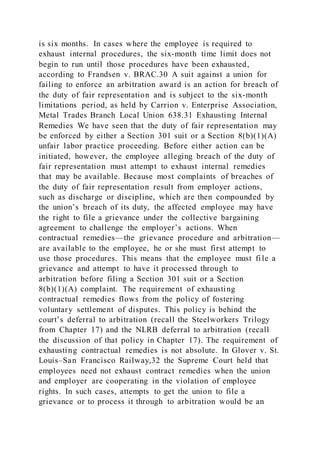








![union must hold elections at least every three years • Elections
shall be by secret ballot or at a convention of delegates chosen
by secret ballot • There must be advance notice of the election,
freedom of choice among candidates, and publication and one
year’s preservation of the election results • Dues and
assessments cannot be used to support anyone’s candidacy •
Every candidate has the right to inspect lists of members’ names
and addresses • Each candidate has the right to have observers
at polling places and at the counting of the ballots In the case of
International Organization for Masters, Mates & Pilots v.
Brown,46 the Supreme Court held that labor unions must
cooperate with all reasonable requests from candidates for
union office to distribute campaign literature despite union
rules restricting such requests. In that case, the Court decided
that a union refusal to provide a membership list to a candidate
because of a union rule prohibiting preconvention mailings was
in violation of the LMRDA. The election provisions of the
LMRDA also prohibit unduly restrictive eligibility requirements
that enable incumbents to become entrenched in office. Such
eligibility requirements are the subject of the following case.
CASE 18.5 heRMaN v. local 1011, uNited SteelwoRkeRS oF
aMeRica 207 F.3d 924 (7th Cir. 2000), cert. denied, 531 U.S.
1010 (2000)
Posner, Chief Judge Section 401(e) of the Labor–Management
Reporting and Disclosure Act [LMRDA] makes all union
members in good standing eligible to run for office in the
union’s elections subject to “reasonable qualifications
uniformly imposed.” The constitution of the steel-workers inter-
national union conditions eligibility for local office on the
member’s having attended at least eight of the local’s monthly
meetings (or been excused from attendance at them, in which
event he must have attended one-third of the meetings from
which he was not excused) within the two years preceding the](https://image.slidesharecdn.com/chapter6classinequalitythischapterwillhelpyoude-220921134236-0a176403/85/Chapter-6Class-InequalityThis-Chapter-Will-Help-YouDe-40-320.jpg)

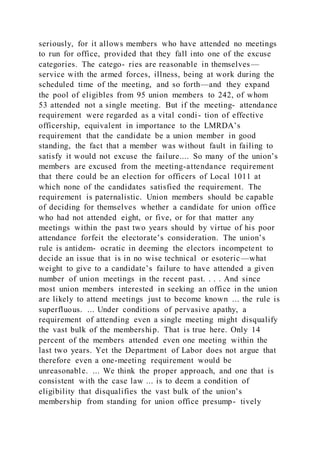








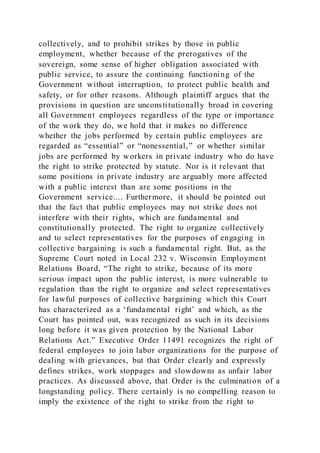


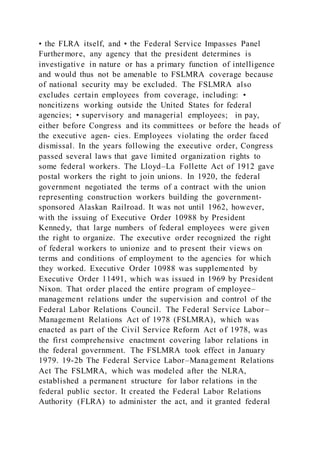



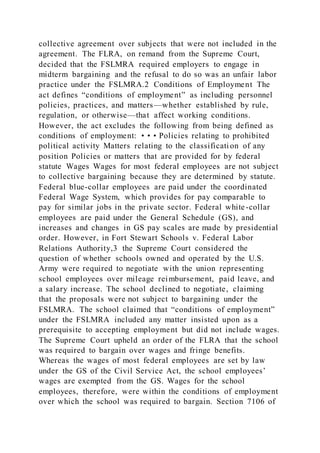


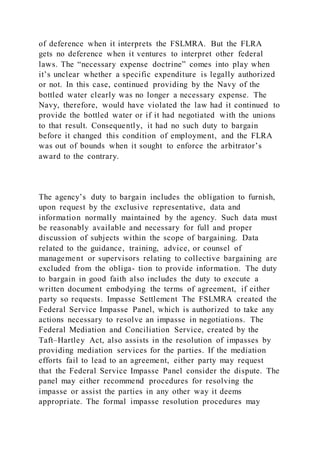








![could not charge for expenses incurred in conducting an illegal
work stoppage or for litigation expenses unless the litigation
concerned the individual’s own bargaining unit. The union
could charge objecting individuals for: • national union
programs and publications designed to disseminate information
germane to collective bargaining; • information services
concerning professional development, job opportunities, and
miscellaneous matters that benefited all teachers, even though
they may not directly concern members of the individual’s
bargaining unit; • participation by local delegates at state or
national union meetings at which representa- tion policies and
bargaining strategies are developed; and • expenses related to
preparation for a strike. The Court also held that the union
could not charge the objecting individuals for public relations
efforts designed to enhance the reputation of the teaching
profession gener- ally because such efforts were not directly
connected to the union’s collective bargaining function. It
should be noted that private sector employees have the same
right to object to political expenditures by their unions; in
Communications Workers of America v. Beck12 (see Chapter
18), the Supreme Court stated that We conclude that Section
8(a)(3) ... authorizes the exaction [from nonmembers or
objecting employees] of only those fees and dues necessary to
“performing the duties of an exclusive representative of the
employees in dealing with the employer on labor–management
issues.” The FSLMRA provides that union dues may be
deducted from an employee’s pay only if authorized by the
employee. The employer may not charge a service fee for
deductions to either the employee or the union. Employee
authorizations for dues deduction may not be revoked for a
period of one year from their making. It is worth noting that in
a still more recent decision, the Supreme Court held that
political action committees (PACs) have a constitutional right
to spend as much money as they wish to promote political
candidates of their choosing. In light of the restrictions placed
upon public-employee unions in the preceding decisions, this](https://image.slidesharecdn.com/chapter6classinequalitythischapterwillhelpyoude-220921134236-0a176403/85/Chapter-6Class-InequalityThis-Chapter-Will-Help-YouDe-70-320.jpg)

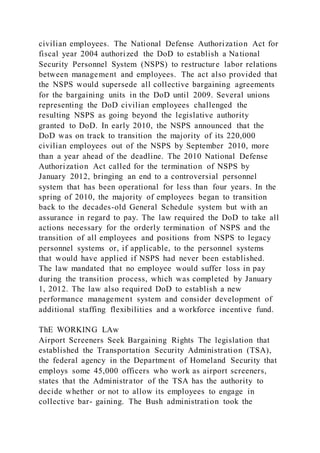

![(FLRA or Authority)—an independent government agency that
oversees federal labor relations—directing an election about
exclusive representation for purposes other than collective
bargaining (65 FLRA No. 53 (2010)).” He then outlined a
framework for labor relation within his agency. This framework
is unique to TSA in that it allows for bargaining at the national
level only. It prohibits local-level bargaining at individual
airports—except on the nonsecurity employment issues
identified in the Determination, such as shift bids, transfers, and
awards. Administrator Pistole’s Determination prohibits
bargaining on any topics that might affect security, such as: •
Security policies, procedures, or the deployment of security
personnel or equipment • Pay, pensions, and any form of
compensation • Proficiency testing • Job qualifications •
Discipline standards The following two decisions of the U.S.
Court of Appeals for the District of Columbia involve the legal
challenges to the DHS and the Department of Defense human
resources management systems by the unions representing their
employees.
CASE 19.4 national treasury emPloyees union v. miChael
Chertoff, seCretary, uniteD states DePartment of homelanD
seCurity 452 F.3d 839 (D.C. Cir. 2006)
Edwards, Senior Circuit Judge When Congress enacted the
Homeland Security Act of 2002 (“HSA” or the “Act”) and
established the Department of Homeland Security (“DHS” or the
“Department”), it provided that “the Secretary of Homeland
Security may, in regulations prescribed jointly with the Director
of the Office of Personnel Management, establish, and from
time to time adjust, a human resources management system.” [5
U.S.C. § 9701 (Supp. II 2002)] Congress made it clear,
however, that any such system “shall—(1) be flexible; (2) be
contemporary; (3) not waive, modify, or otherwise affect](https://image.slidesharecdn.com/chapter6classinequalitythischapterwillhelpyoude-220921134236-0a176403/85/Chapter-6Class-InequalityThis-Chapter-Will-Help-YouDe-74-320.jpg)
![[certain existing statutory provisions relating to ... merit hiring,
equal pay, whistle blowing, and prohibited personnel practices],
[and] (4) ensure that employees may organize, bargain
collectively, and participate through labor orga- nizations of
their own choosing in decisions which affect them, subject to
any exclusion from coverage or limitation on negotiability
established by law.” The Act also mandated that DHS
employees receive “fair treatment in any appeals that they bring
in decisions relating to their employment.” Section 9701 does
not mention “Chapter 71,” which codi- fies the Federal Services
Labor–Management Statute and delineates the framework for
collective bargaining for most federal sector employees. In
February 2005, the Department and Office of Personnel
Management (“OPM”) issued regulations establishing a human
resources management system ... [the] Department of Homeland
Security Human Resources Management System (“Final Rule”
or “HR system”). The Final Rule ... defines the scope and
process of collective bargaining for affected DHS employees,
channels certain disputes through the Federal Labor Relations
Authority (“FLRA” or the “Authority”), creates an in-house
Homeland Security Labor Relations Board (“HSLRB”), and
assigns an appellate role to the Merit Systems Protection Board
(“MSPB”) in cases involving penal- ties imposed on DHS
employees. Unions representing many DHS employees filed a
complaint in [District of Columbia] District Court ...
challeng[ing] aspects of the Final Rule. ... the District Court
found that the regulations would not ensure collec- tive
bargaining, would fundamentally and impermissibly alter FLRA
jurisdiction, and would create an appeal process at MSPB that is
not fair. Based on these rulings, the District Court enjoined
DHS from implementing [certain sections] ... of the regulations.
However, the District Court rejected the Unions’ claims that the
regulations impermissibly restricted the scope of bargaining and
that DHS lacked authority to give MSPB an intermediate
appellate function in cases involving mandatory removal
offenses. ... The case is now before this court on appeal by the](https://image.slidesharecdn.com/chapter6classinequalitythischapterwillhelpyoude-220921134236-0a176403/85/Chapter-6Class-InequalityThis-Chapter-Will-Help-YouDe-75-320.jpg)




![exercises of management rights. • The regulations limit
collective-bargaining rights over pay and benefits for employees
of certain DoD units known as “non-appropriated fund
instrumentalities.” These em- ployees’ compensation is not set
by statute and is there- fore traditionally subject to collective
bargaining.... [S]ubsection (m) of Section 9902 grants DoD
expansive authority to curtail collective bargaining through
November 2009.... After November 2009, however, the
authority in subsection (m) runs out, and collective bargaining
under Chapter 71 again will structure the Department’s labor
relations ... In effect, therefore, the Act sets up a tempo- rary,
experimental period through November 2009 during which DoD
has broad leeway to restructure its labor relations system. But
after November 2009, assuming that Congress has not amended
the statute in the meantime, the Chapter 71 collective-
bargaining requirements ... again will apply and govern labor
relations for DoD’s civilian workers (subject to targeted
exceptions). ... In sum, we hold that the plain language of the
National Defense Authorization Act authorizes DoD to curtail
collective bargaining for DoD’s civilian employees through
November 2009. For purposes of our analysis, we find the
relevant statutory terms plain.... Because we conclude that the
National Defense Authorization Act authorizes DoD to curtail
collective bargaining, we reverse the contrary judgment of the
District Court.... We reverse the judgment of the District Court
and uphold the DoD regulations at issue in this appeal. So
ordered. Case Questions 1. As noted, the court of appeals held
that the DHS regulations were invalid but upheld the
Department of Defense regulations. Because the intent and the
effects of the regulations in both cases were similar, how can
you explain the different results in the two decisions? 2. In the
DHS decision, what reasons did the court give for holding that
the regulations failed to ensure the rights of the employees to
bargain collectively? 3. In the Department of Defense case, how
did the NSPS limit the scope of collective bargaining for the
civilian employees? Were the restrictions on collective](https://image.slidesharecdn.com/chapter6classinequalitythischapterwillhelpyoude-220921134236-0a176403/85/Chapter-6Class-InequalityThis-Chapter-Will-Help-YouDe-80-320.jpg)





![proportionate share of the costs of collective bargaining and
contract administration. 4. The provision prohibiting municipal
employers from deducting labor organization dues from the
paychecks of general employees. 5. The provision requiri ng
annual recertification elections of the representatives of all
bargaining units, requiring 51% of the votes of the bargaining
unit members (regardless of the number of members who vote),
and requiring the commission to assess costs of such elections.
Decision: Before the enactment of Act 10, general employees
were permitted under MERA to collectively bargain over a
broad array of subjects, including wages, working conditions,
work hours, and grievance proce- dures. Act 10 limits collective
bargaining between munic- ipal employers and the certified
representatives of general employees to the single topic of
“total base wages and excludes any other compensation....”
Moreover, Act 10 prohibits collective bargaining for base wage
increases that exceed an increase in the Consumer Price Index
unless approved in a municipal voter referendum. The plain-
tiffs argue this limitation penalizes general employees who
choose to be represented by a certified representative because
Act 10 imposes no limitations whatsoever on the terms that non-
represented general employees may nego- tiate with their
municipal employers. Consequently, the plaintiffs contend, Act
10 unconstitutionally burdens the associational rights of general
employees because they must surrender their association with a
certified representative in order to negotiate anything beyond
base wages. General employees have no constitutional right to
nego- tiate with their municipal employer on the lone issue of
base wages, let alone on any other subject. As the United States
Supreme Court made clear: [While t]he public employee surely
can associate and speak freely and petition openly, and he is
protected by the First Amendment from retaliation for doing
so.... [,] the First Amendment does not impose any affirmati ve
obligation on the government to listen, to respond or, in this
context, to recognize the association and bargain with it. Smith
v. Ark. State Highway Emps., Local 1315, 441 U.S. 463, 465,](https://image.slidesharecdn.com/chapter6classinequalitythischapterwillhelpyoude-220921134236-0a176403/85/Chapter-6Class-InequalityThis-Chapter-Will-Help-YouDe-86-320.jpg)
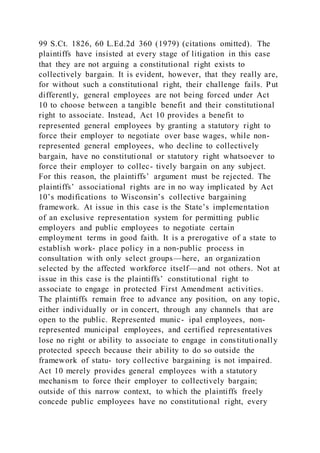










![representatives of Madison Teachers Inc., to appear and speak
at meetings of the Board of Education, on matters subject to
collective bargaining between it and Madison Teachers, Inc.”
The Commission’s action was affirmed by the Circuit Court of
Dane County. The Supreme Court of Wisconsin affirmed. The
court recognized that both the Federal and State Constitutions
protect freedom of speech and the right to petition the
government, but noted that these rights may be abridged in the
face of “a clear and present danger that [the speech] will bring
about the substantive evils that [the legislature] has a right to
prevent.” The court held that abridgment of the speech in this
case was justified in order “to avoid the dangers attendant upon
relative chaos in labor management relations.” The Wisconsin
court perceived “clear and present danger” based upon its
conclusion that Holmquist’s speech before the school board
constituted “negotiation” with the board. Permitting such
“negotiation,” the court reasoned, would undermine the
bargaining exclusivity guaranteed the majority union under Wis.
Stat. Section 111.70(3)(a)(4) (1973). From that premise it
concluded that teachers’ First Amendment rights could be
limited. Assuming, arguendo, that such a “danger” might in
some circumstances justify some limitation of First Amendment
rights, we are unable to read this record as presenting such
danger as would justify curtailing speech. The Wisconsin
Supreme Court’s conclusion that Holmquist’s terse statement
during the public meeting constituted negotiation with the board
was based upon its adoption of the lower court’s determination
that, “[e]ven though Holmquist’s statement superficially
appears to be merely a ‘position statement,’ the court deems
from the total circumstances that it constituted ‘negotiating.’”
This cryptic conclusion seems to ignore the ancient wisdom that
calling a thing by a name does not make it so. Holmquist did
not seek to bargain or offer to enter into any bargain with the
board, nor does it appear that he was authorized by any other
teachers to enter into any agreement on their behalf. Although
his views were not consistent with those of MTI,](https://image.slidesharecdn.com/chapter6classinequalitythischapterwillhelpyoude-220921134236-0a176403/85/Chapter-6Class-InequalityThis-Chapter-Will-Help-YouDe-98-320.jpg)




